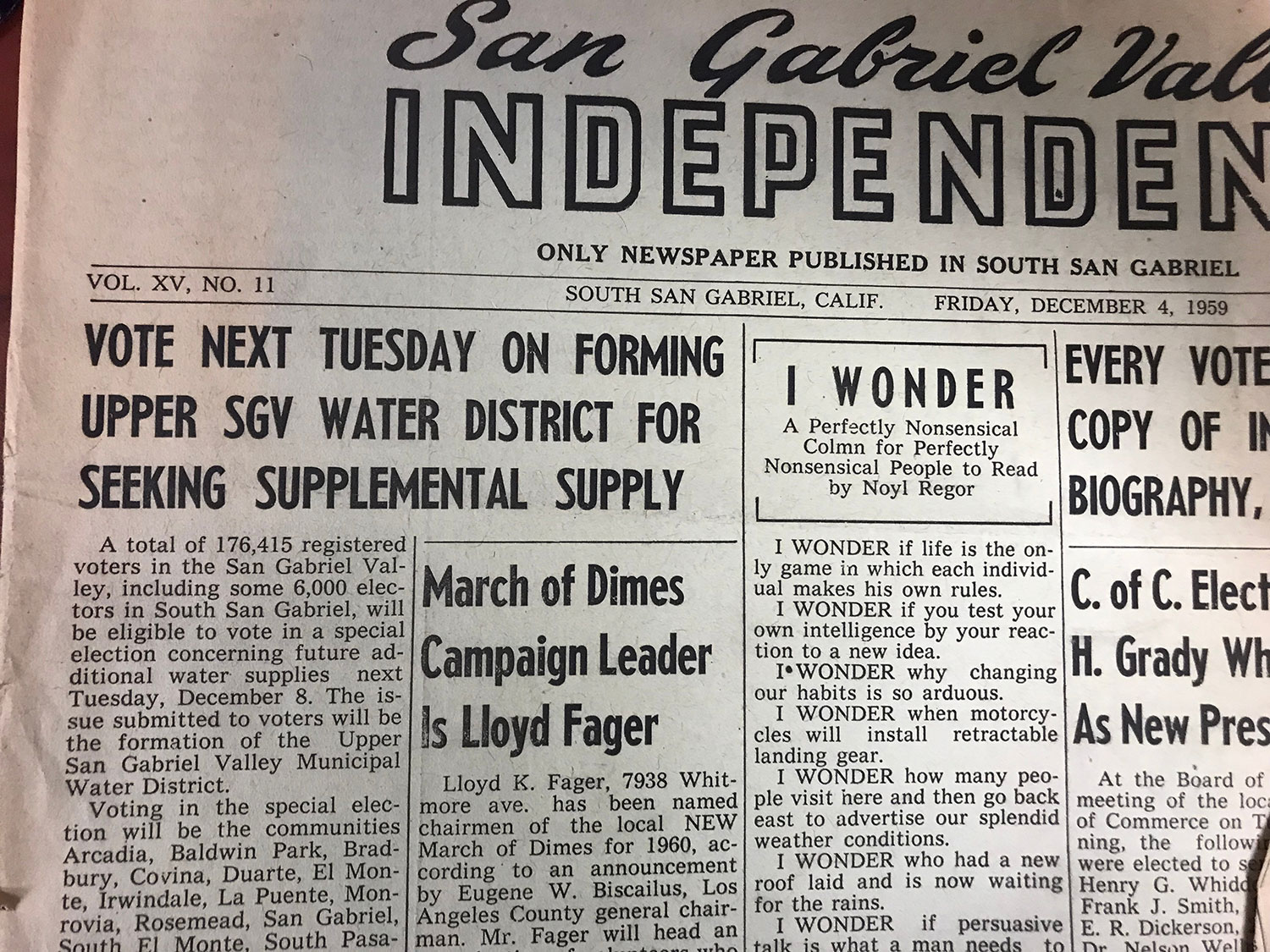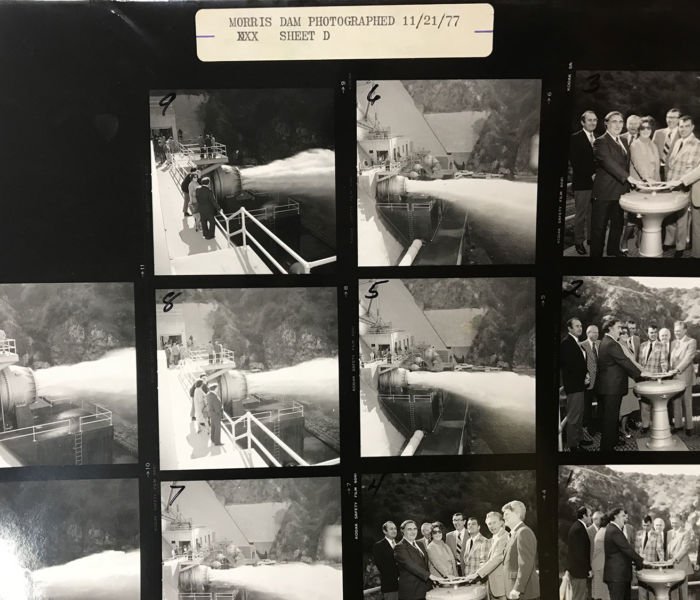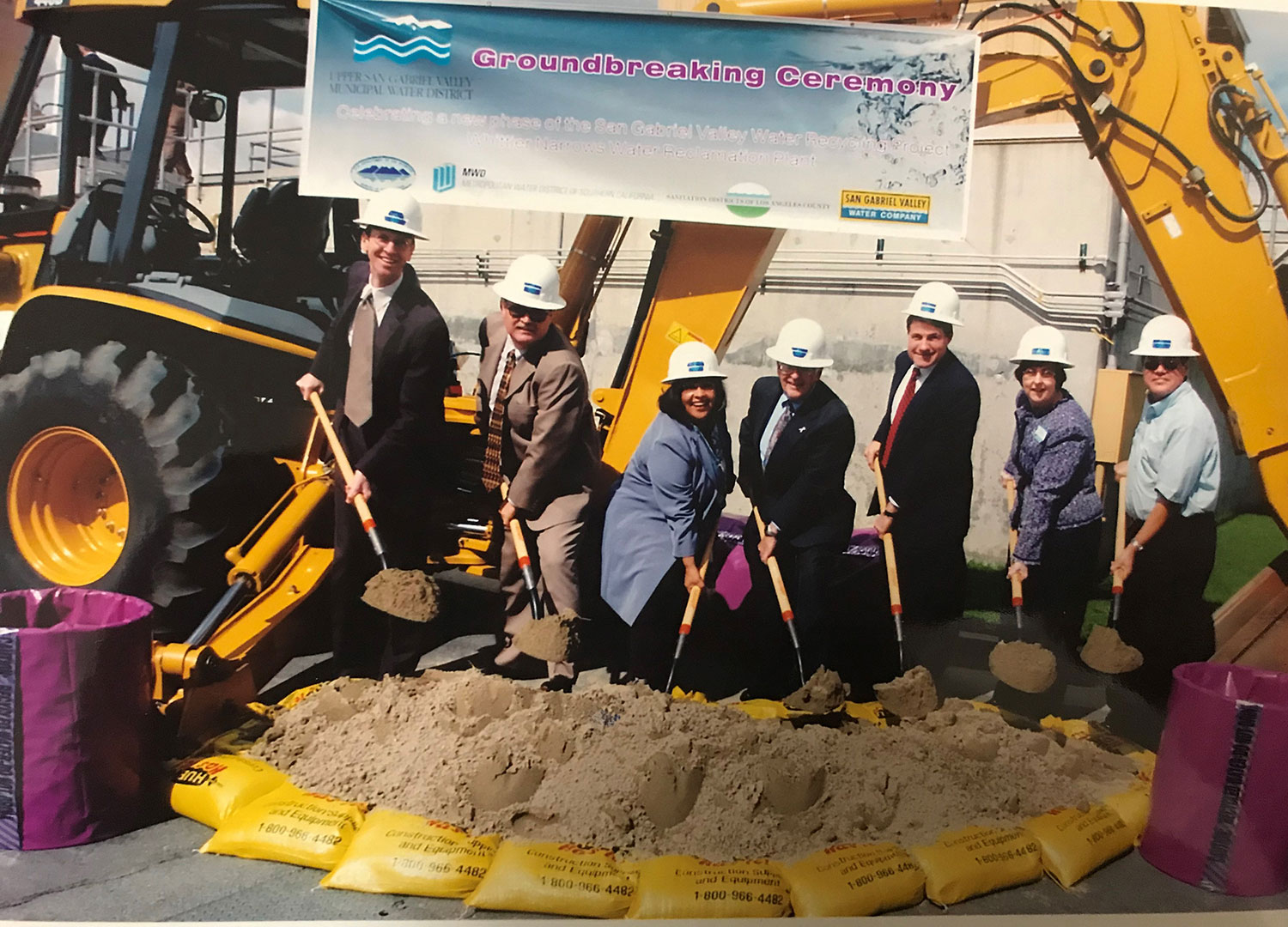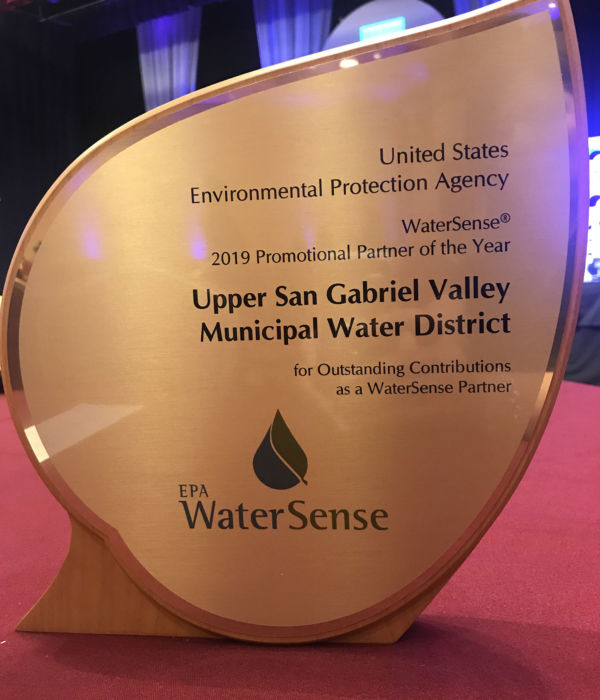History of the Upper San Gabriel Valley Municipal Water District
The Early Years
Before the formation of Upper District, the San Gabriel Valley was a dynamic valley rich with the potential of greatness. In the early 1930s the valley was a productive land bursting with citrus orchards that gave way to a community of homes, thriving businesses and emerging industries that established a firm base for the growing wealth of the San Gabriel Valley. From the beginning, the story of the valley is similar to the booming growth story of Southern California, which is bound to the story of water. The San Gabriel Valley is unique and fortunate to have a vast underground water supply that at one time, seemed inexhaustible. By the early 1950s, the San Gabriel Valley water producers faced the sobering fact that the demand would soon outstrip the supply as the region experienced rapid urbanization and population spikes.
The region’s water providers under the San Gabriel Valley Water Association believed they needed a stronger voice to advocate for the region’s water supply needs. Compounding this was the filing of the Long Beach Suit on May 12, 1959, by the City of Long Beach, Compton and the Central Basin Municipal Water District in which the water providers from the Upper Basin were named as defendants in a water rights lawsuit. The plaintiffs requested the court to limit the amount of water the providers could pump from the Main San Gabriel Groundwater Basin. Concerned with the potential pumping limitation, the water providers found it imperative to identify additional sources of water, thus began the campaign to create a municipal water district.
Formation of the District
A special election was held on December 8, 1959 to ask the voters if they approved the creation of a municipal water district to supplement current local water supplies. With overwhelming support from the voters, the initiative passed. The original cities that were included in the service area were Arcadia, Baldwin Park, Bradbury, Covina, City of Industry, Duarte, El Monte, Irwindale, La Puente, Monrovia, Rosemead, San Gabriel, South El Monte, South Pasadena, South Gabriel, Temple City and portions of Glendora and Azusa. West Covina subsequently joined in 1965.
The California Secretary of State officially incorporated the district on January 7, 1960, establishing service boundaries and a board governance structure with five elected members each representing a geographical region. Upper District’s first meeting was held on January 11, 1960 in Temple City with the swearing-in of its very first board of directors: J. Ercel Cleminson, President; Frank E Vachon, Vice President; Howard H. Hawkins, Secretary-Treasurer; and William K. Foerster and Robert T. Radford. Within the next few months, Carl F. Fossette was appointed General Manager, Richard Vicenti was appointed Auditor and Ralph B. Helm was appointed Attorney for the District.

Securing a Safe and Reliable Water Supply
Upper District retained the firm of Stetson, Strauss and Dresselhaus, Inc., in November of 1961 to provide a survey and report on a source of supplemental water supply for the region. Thomas Stetson, the lead engineer, brought forth a report known as the “Stetson Report” the following year. This report included the careful analysis of four possible sources of water: water from the Colorado River Aqueduct, water from the Feather River project which later became known as the State Water Project, reclamation of sewage water known as recycled water, and demineralization of sea water known as desalination.
The report estimated that an additional 133,000 acre-feet of water would be needed annually by the year 1990. Colorado River water was also identified to be the safest and most affordable source of supply and could be obtained by joining the Metropolitan Water District of Southern California (Metropolitan).
Confident with the Stetson Report findings and with support from the San Gabriel Valley Water Association, Upper District began annexation negotiations with Metropolitan. On January 15, 1963, the Board of Directors led by President J. Ercel Cleminson voted to hold a special election on March 12, 1963 to present the annexation initiative to the voters. A public opinion poll showed that annexation was supported 20 to 1. The initiative passed with 81% of voter approval. With this passage, Upper District now had the capability to import water supplies from the Colorado River and eventually import water from the State Water Project in the 1970s. As a member agency of Metropolitan, J. Ercel Cleminson and Howard H. Hawkins were appointed as Upper District’s first representatives to the Metropolitan Water District Board of Directors.
In order to deliver the imported water to the region, an agreement was negotiated in 1969 between Carl Fossette, General Manager of Upper District, and Metropolitan General Manager Henry Mills to construct a pipeline connection known as the USG-3 Service Connection. Upper District took a leadership role in determining the water rights within the San Gabriel Valley in 1973. This case of Upper San Gabriel Valley Municipal Water District, Plaintiff, v. City of Alhambra, et al, Defendants, brought about the creation of the Main San Gabriel Basin Watermaster which was ordered by the court to administer and enforce provisions of the judgment.

Jane Bray, Upper District’s first female general manager, helped facilitate the ownership transfer of Morris Dam and Reservoir from Metropolitan Water District to the Los Angeles County Flood Control District in November of 1974. Severe contamination of the groundwater basin was discovered in the San Gabriel Valley in 1979. With approximately 80 percent of the regional water supply coming from local groundwater, removing the contaminants became a regional priority for Upper District. To assist with the remediation of the groundwater, Upper District entered into a cooperative agreement with the Environmental Protection Agency (EPA).
Working with its water providers, Upper District took the lead in initiating a water-quality monitoring program involving chemical and physical constituents in the local domestic water supplies. Through this program, the District coordinated the removal of contaminated wells from service, blended contaminated water with other water sources, and helped install treatment systems to meet health standards and protect the public. Upper District was also instrumental in the formation of the San Gabriel Basin Water Quality Authority (WQA). This new agency was first developed as a cooperative venture among Upper District, Watermaster and water providers to coordinate the groundwater clean-up. In 1992, WQA was formally recreated by the State of California.
Working to Drought-Proof the Main San Gabriel Basin
The region’s reliance on imported water supplies has left it vulnerable to variable climates, drought cycles and limited imported water availability. For these reasons, the Board of Directors found it necessary to continue the search for alternative sources of water for regional independence and reliability. Starting in the 1980s and more aggressively in the 1990s, Upper District pursued both long-term water conservation programs and reclaimed water reuse projects to drought proof the Main San Gabriel Basin.
Upper District explored a Groundwater Recharge Project in partnership with the Los Angeles County Sanitation Districts from 1991 to 2000 for 30,000 to 50,000 AFY (acre-feet/year) of reclaimed water. the Board of Directors approved a feasibility study and implementation program in late 1991 for reclaimed water that identified potential beneficiary users, funding sources and infrastructure that would be needed to support the project. In fiscal year 1992/93 Upper District received $25 million of Title XVI grant funds for the project. Un-supportive of this endeavor, Miller Brewing Company launched a public relations campaign, Toilet to Tap, to tarnish the integrity and support from other entities. Rather than abandoning the project, Upper District and its partners undertook efforts to educate the public about the value of water recycling through public surveys and town hall meetings. The District also made efforts to redesign the project plans to overcome objections from Miller Brewing Company, which later stepped back from their opposition.
Upper District was awarded in 1998 with the Special Award of Merit by WateReuse Association of California and the Project of the Year Award by the Urban Water Institute for its water reclamation efforts. In May 2000, Upper District’s Groundwater Recharge Project downsized to 10,000 AFY and the project name was changed to the Demonstration Groundwater Recharge Project.
Reclamation efforts continued in the early 2000s in partnership with Upper District’s water retailer. They worked together to develop water recycling projects for landscape irrigation throughout the San Gabriel Valley. In 2002, Rose Hills recycled water program was the first project completed for indirect potable reuse with local, state and federal funding sources of approximately $3.5 million and produced approximately 900 AFY. Additional recycled water projects for irrigation were constructed in 2004 with the Whittier Narrows Project; the Whittier Narrows Expansion Project in 2006; the City of Industry Expansion Project in 2008; the Rose Hills Expansion Project in 2017; the South El Monte Recycled Water Project in 2018; and most recently the La Puente Valley County Water District Recycled Water Project in 2020.

The Demonstration Groundwater Recharge Project reorganized in March of 2010 into the Groundwater Reliability Improvement Program (GRIP) Joint Powers Authority and formed with Water Replenishment District of Southern California, Los Angeles County Sanitation District and Upper District. Upper District exited GRIP in 2011 and the Board of Directors directed staff to develop Upper District’s groundwater recharge project known as the Indirect Reuse Replenishment Project (IRRP).
Leading Efforts in Water Conservation
The first steps in establishing conservation programs were taken in the 1990s. These actions defined the agency as the lead environmental steward for the region. The creation of the San Gabriel River Watershed Restoration Program in 1991 was a first-of-its-kind program that focused on maintaining a healthy watershed and mitigate the negative impacts affecting our local groundwater. Upper District has been able to expand its program due to the supportive partnership with the U.S. Department of Agriculture Forest Service. For the last 29 years, 13,000 volunteers have donated 79,000 community service hours to plant over 140,000 tree saplings, collect 133 pounds of acorns and 4,853 pounds of garbage in the San Gabriel River Watershed.

The Board of Directors signed a historic water conservation pact, the Best Management Practices agreement, with numerous statewide water agencies in 1992. The conservation pact motivated the Board to authorize a plumbing retrofit program, ultra-low flush toilet retrofit program and youth targeted activities that promoted water awareness and conservation. The Board also focused its attention on outreach efforts through community meetings, paid advertisement, and speakers’ bureaus. Since then, the District has led the region’s efforts in educating residents on water-use efficiency practices in addition to promoting Metropolitan Water District’s conservation programs.
Some of Upper District’s programs include: Smart Gardening Classes, Leak Detection Workshops, High Efficiency Toilet Giveaways, Rain Barrel Giveaways, Large Landscape & Survey Retrofit Program, the San Gabriel Valley Water Smart City Challenge, Sustainable Landscape Demonstration Gardens, Residential Plant Voucher Pilot Program, Water Bottle Filling Station Pilot Program, and WaterFest.
Upper District’s outreach and conservation programs has earned the agency regional, state and national recognition. In September 2015, Upper District was awarded the San Gabriel Valley Council of Governments’ 2015 Sustainability Award and the California Special Districts Association’s 2015 Excellence in Outreach Award for its first-of-its-kind water conservation program, the San Gabriel Valley Water Smart City Challenge. In June 2016, the San Gabriel Valley Regional Chamber of Commerce awarded Upper District with Business of the Year for its broad public outreach activities on water conservation. Recently, Upper District was honored with the prestigious WaterSense 2019 Promotional Partner of the Year Award from the U.S. Environmental Protection Agency.
Upper District Role Today
Upper District’s history is filled with many “firsts” and has become an agency that is respected for its environmental stewardship, water policy and innovation. In November of 2019, Upper District’s Board of Directors hit two major “firsts” with the re-election of its longest serving board member of 28 years and the election of its first female board member. After 60 years, Upper District remains committed to its mission to consistently meet the region’s need for a safe, reliable and high-quality water supply.